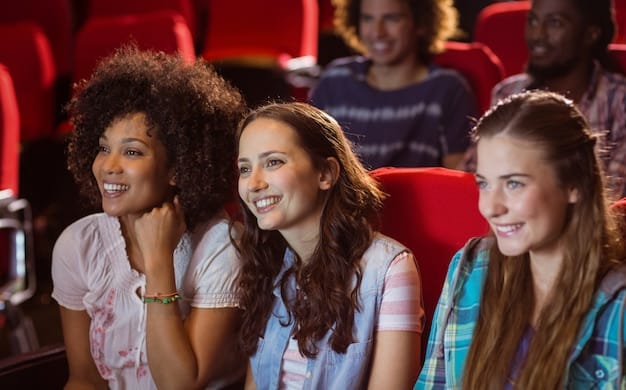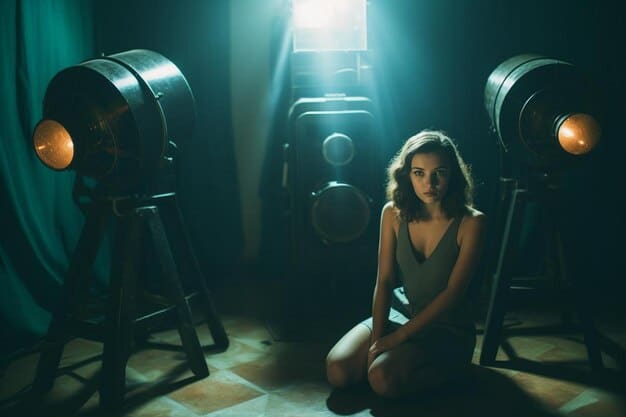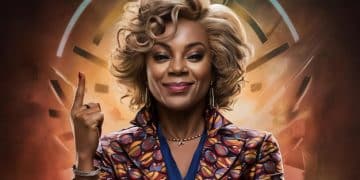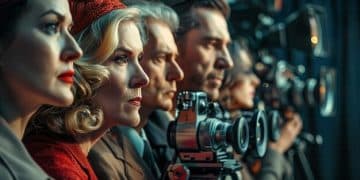The Rise of the Female Director: Hollywood’s Glass Ceiling Shattered

The rise of the female director signifies a pivotal shift in Hollywood, challenging historical underrepresentation and showcasing unique perspectives that enrich the world of cinema.
The film industry, long dominated by male voices, is witnessing a powerful change: the rise of the female director: breaking barriers in Hollywood. This movement is reshaping storytelling and offering fresh perspectives on the silver screen.
The Historical Underrepresentation of Female Directors
For decades, Hollywood has been criticized for its lack of diversity, particularly when it comes to female directors. This section explores the historical context and the systemic issues that have contributed to this underrepresentation.
Understanding the historical landscape is crucial to appreciating the progress being made today. The film industry, from its inception, has been largely controlled by men, both in front of and behind the camera.
Early Challenges Faced by Women in Film
In the early days of cinema, women faced immense challenges in gaining access to directorial roles. Despite some pioneering female filmmakers, their contributions were often marginalized.
The Persistence of the “Boys’ Club”
The persistence of a “boys’ club” mentality in Hollywood has made it difficult for women to break through. This culture often excludes women from crucial networking opportunities and decision-making processes.
- Limited access to funding and resources.
- Stereotypical portrayals of women in film.
- Lack of female mentors and role models.
- Discrimination in hiring practices.
The systemic issues that have plagued Hollywood have created significant obstacles for women aspiring to direct. Addressing these issues requires a multifaceted approach, including policy changes, increased awareness, and a commitment to inclusivity.
Notable Female Directors Who Paved the Way
Despite the challenges, several trailblazing female directors have made significant contributions to cinema. This section highlights some of the most influential women who paved the way for future generations.
These women overcame significant obstacles to achieve success in a male-dominated industry. Their work not only entertained audiences but also challenged societal norms and expectations.

Dorothy Arzner: A Pioneer of Early Hollywood
Dorothy Arzner was one of the few female directors working in Hollywood’s Golden Age. She directed numerous successful films and was known for her innovative camera techniques.
Ida Lupino: Breaking Ground in the 1950s
Ida Lupino was a talented actress who transitioned to directing in the 1950s. She directed several noir films that tackled controversial social issues.
These women demonstrated resilience and talent, inspiring future generations of female directors. Their contributions were often overlooked, but their impact is undeniable.
The Current Landscape: More Opportunities, More Recognition
The film industry is now seeing a surge in the number of female directors gaining recognition and opportunities. This section examines the factors contributing to this positive shift.
Increased awareness of gender inequality and the advocacy efforts of various organizations have helped to create a more inclusive environment. Studios are now recognizing the value of diverse perspectives.
The Influence of the #MeToo Movement
The #MeToo movement has brought attention to issues of sexual harassment and discrimination in Hollywood, leading to greater accountability and a push for change.
Initiatives Promoting Gender Equality
Numerous organizations and initiatives are working to promote gender equality in the film industry, providing support and resources for female filmmakers.
- Mentorship programs for aspiring female directors.
- Funding opportunities specifically for female-led projects.
- Advocacy efforts to increase female representation in film.
- Film festivals that showcase the work of female directors.
These initiatives are helping to level the playing field and create more opportunities for women to succeed in the film industry. The changing landscape reflects a growing recognition of the need for diverse voices in storytelling.
The Impact of Female Directors on Storytelling
Female directors bring unique perspectives and experiences to storytelling, enriching the cinematic landscape. This section explores the ways in which their work differs from that of their male counterparts.
Women often bring a different sensibility to their films, exploring themes and characters in ways that resonate with diverse audiences. Their stories often challenge traditional gender roles and offer nuanced perspectives on complex issues.

Exploring Female-Centric Narratives
Female directors are more likely to create films that center on female characters and explore their experiences. These narratives provide much-needed representation and challenge stereotypical portrayals.
Challenging Gender Stereotypes
Many female directors use their films to challenge traditional gender stereotypes and promote more nuanced representations of women and men.
The impact of female directors on storytelling is profound, adding depth and complexity to the cinematic experience. Their films offer fresh perspectives and challenge audiences to rethink their assumptions.
Financial Success and Critical Acclaim
The films of female directors are not only artistically significant but also commercially successful. This section highlights examples of female-directed films that have achieved both financial success and critical acclaim.
The notion that films directed by women are not profitable is simply untrue. Numerous female-directed films have shattered box office records and received widespread critical praise.
Box Office Hits Directed by Women
Films like “Wonder Woman” directed by Patty Jenkins and “Captain Marvel” co-directed by Anna Boden have proven that female-directed superhero films can be major box office hits.
Award-Winning Films Directed by Women
Films like “Nomadland” directed by Chloé Zhao and “The Hurt Locker” directed by Kathryn Bigelow have won numerous awards, including Academy Awards for Best Director and Best Picture.
- “Lady Bird” directed by Greta Gerwig.
- “Selma” directed by Ava DuVernay.
- “Zero Dark Thirty” directed by Kathryn Bigelow.
The success of these films demonstrates that female directors are capable of creating compelling and commercially viable films. Their achievements are helping to dismantle the myth that women cannot succeed in Hollywood.
The Future of Female Directors in Hollywood
The future looks promising for female directors in Hollywood. With increased awareness, advocacy, and opportunities, more women are poised to make their mark on the film industry. This section discusses the ongoing efforts to support female filmmakers and the challenges that still remain.
While progress has been made, there is still work to be done to ensure that women have equal opportunities in Hollywood. Addressing issues such as pay inequality and unconscious bias is crucial to creating a truly inclusive industry.
Continuing the Fight for Gender Equality
Organizations and individuals must continue to advocate for gender equality in Hollywood, pushing for policy changes and greater accountability.
Supporting Emerging Female Talent
Providing support and resources for emerging female filmmakers is essential to ensuring that the next generation has the opportunity to succeed.
The future of female directors in Hollywood is bright, but it requires continued commitment and effort. By supporting female filmmakers and challenging systemic biases, the industry can create a more inclusive and equitable environment for all.
| Key Point | Brief Description |
|---|---|
| 🎬 Historical Underrepresentation | Women faced systemic barriers in early Hollywood and beyond |
| 🌟 Pioneering Directors | Trailblazers like Dorothy Arzner and Ida Lupino paved the way. |
| 🚺 Current Landscape | More opportunities and recognition for female directors today. |
| 💰 Success Stories | Films directed by women achieve critical and financial success. |
FAQ
▼
Early Hollywood was heavily influenced by societal norms that limited women’s access to leadership positions. A pervasive “boys’ club” culture further hindered their opportunities and recognition.
▼
Dorothy Arzner, a prominent director during Hollywood’s Golden Age, and Ida Lupino, who broke ground in the 1950s by directing noir films, are two notable examples of pioneering female directors.
▼
The #MeToo movement spotlighted issues of sexual harassment and discrimination, fostering greater accountability and advocacy for gender equality in Hollywood, thereby creating a more supportive environment.
▼
Female directors demonstrate their talent across various genres, including superhero films, indie dramas, and historical epics, proving their versatility and skill in storytelling.
▼
Providing mentorship programs, funding opportunities, and continued advocacy for gender equality are crucial steps to fostering the growth and success of female directors in Hollywood.
Conclusion
The journey of female directors in Hollywood has been one of perseverance and triumph. While challenges remain, the progress made is undeniable, and the future holds immense potential for women to shape the cinematic landscape.





